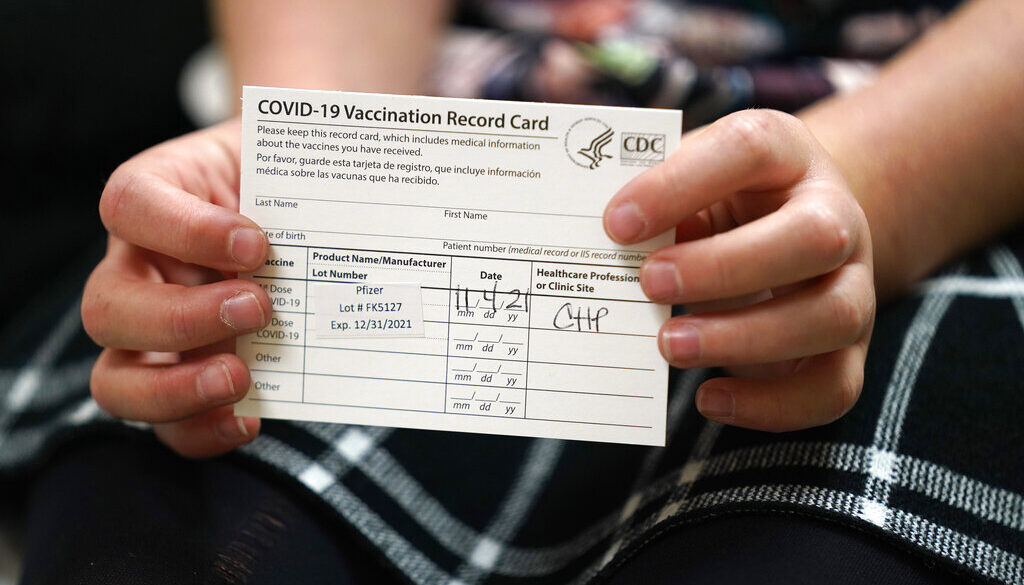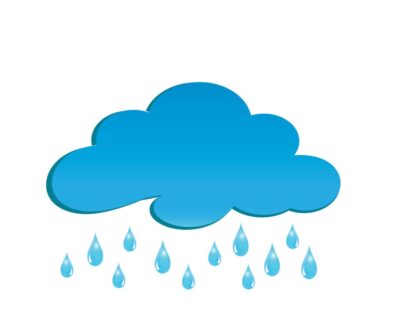Omicron takes over, cases rise among vaccinated
9 year-old Josie Murdoch holds her vaccination card at Chapel Hill Pediatrics and Adolescents after being innoculated with the Pfizer child COVID-19 vaccination in Chapel Hill, N.C., Thursday, Nov. 4, 2021. (AP Photo/Gerry Broome)
RALEIGH — On September 9, President Joe Biden called COVID-19 “a pandemic of the unvaccinated.” New data from the U.S. and around the world suggests the new omicron variant may be impacting vaccinated people more than the unvaccinated.
U.S. government figures show the omicron variant continues to account for a growing proportion of new coronavirus infections in the country. Omicron accounted for 59% of new cases in the U.S. for the week ending Dec. 25, according to updated data from the Centers for Disease Control and Prevention. That’s up from 23% the previous week.
Initial data in the U.S. on omicron showed that three-fourths of the initial cases were among those who were vaccinated. While federal authorities have not released updated data on the now dominant strain, other countries have released data that indicates omicron could be as much as 80% breakthrough cases — infections in people who are vaccinated.
The CDC said last week that omicron already accounted for a majority of new cases in the country. But the agency said Tuesday it significantly lowered that previous estimate based on additional data it collected.
Still, it noted that omicron is accounting for a growing proportion of cases.
The rapid spread comes after the first confirmed case of omicron in the U.S. was identified earlier this month. Studies have provided early hints that it is milder than the delta variant.
Federal health officials on Monday cut isolation restrictions for asymptomatic Americans who catch the coronavirus from 10 to five days, and similarly shortened the time that close contacts need to quarantine.
CDC officials said the guidance is in keeping with growing evidence that people with the coronavirus are most infectious in the two days before and three days after symptoms develop.
The decision also was driven by a recent surge in COVID-19 cases, propelled by the omicron variant.
Early research suggests omicron may cause milder illnesses than earlier versions of the coronavirus. But the sheer number of people becoming infected — and therefore having to isolate or quarantine — could impact the ability of hospitals, airlines and other businesses to stay open, experts say.
CDC Director Rochelle Walensky said the country is about to see a lot of omicron cases.
“Not all of those cases are going to be severe. In fact many are going to be asymptomatic,” she told The Associated Press on Monday. “We want to make sure there is a mechanism by which we can safely continue to keep society functioning while following the science.”
Last week, the agency loosened rules that previously called on health care workers to stay out of work for 10 days if they test positive. The new recommendations said workers could go back to work after seven days if they test negative and don’t have symptoms. And the agency said isolation time could be cut to five days, or even fewer, if there are severe staffing shortages.
Now, the CDC is changing the isolation and quarantine guidance for the general public to be even less stringent.
The change is aimed at people who are not experiencing symptoms. People with symptoms during isolation, or who develop symptoms during quarantine, are encouraged to stay home.
The CDC’s isolation and quarantine guidance has confused the public, and the new recommendations are “happening at a time when more people are testing positive for the first time and looking for guidance,” said Lindsay Wiley, an American University public health law expert.
Nevertheless, the guidance continues to be complex.
ISOLATION
The isolation rules are for people who are infected. They are the same for people who are unvaccinated, partly vaccinated, fully vaccinated or boosted.
They say:
—The clock starts the day you test positive.
—An infected person should go into isolation for five days, instead of the previously recommended 10.
—At the end of five days, if you have no symptoms, you can return to normal activities but must wear a mask everywhere — even at home around others — for at least five more days.
—If you still have symptoms after isolating for five days, stay home until you feel better and then start your five days of wearing a mask at all times.
QUARANTINE
The quarantine rules are for people who were in close contact with an infected person but not infected themselves.
For quarantine, the clock starts the day someone is alerted they may have been exposed to the virus.
Previously, the CDC said people who were not fully vaccinated and who came in close contact with an infected person should stay home for at least 10 days.
Now the agency is saying only people who got booster shots can skip quarantine if they wear masks in all settings for at least 10 days.
That’s a change. Previously, people who were fully vaccinated — which the CDC has defined as having two doses of the Pfizer or Moderna vaccines, or one dose of the Johnson & Johnson vaccine — could be exempt from quarantine.
Now, people who got their initial shots but not boosters are in the same situation as those who are partly vaccinated or are not vaccinated at all: They can stop quarantine after five days if they wear masks in all settings for five days afterward.
FIVE DAYS
Suspending both isolation and quarantine after five days is not without risk.
A lot of people get tested when they first feel symptoms, but many Americans get tested for others reasons, like to see if they can visit family or for work. That means a positive test result may not reveal exactly when a person was infected or give a clear picture of when they are most contagious, experts say.
When people get infected, the risk of spread drops substantially after five days, but it does not disappear for everyone, said Dr. Aaron Glatt, a New York physician who is a spokesman for the Infectious Diseases Society of America.
“If you decrease it to five days, you’re still going to have a small but significant number of people who are contagious,” he said.
That’s why wearing masks is a critical part of the CDC guidance, Walensky said.
VARYING RECOMMENDATIONS
The new CDC guidance is not a mandate; it’s a recommendation to employers and state and local officials. Last week, New York state said it would expand on the CDC’s guidance for health care workers to include employees who have other critical jobs that are facing a severe staffing shortage.
It’s possible other states will seek to shorten their isolation and quarantine policies, and CDC is trying to get out ahead of the shift. “It would be helpful to have uniform CDC guidance” that others could draw from, rather than a mishmash of policies, Walensky said.
Given the timing with surging case counts, the update “is going to be perceived as coming in response to pressure from business interests,” Wiley said. But some experts have been calling for the change for months, because shorter isolation and quarantine periods appeared to be sufficient to slow the spread, she said.
The move by CDC follows a decision last week by U.K. officials to reduce the self-isolation period for vaccinated people who test positive for COVID-19.
The Associated Press contributed to this report.
 Twitter
Twitter Facebook
Facebook Instagram
Instagram


